Solidus
Solidus, gold coin introduced by Emperor Constantine I (fig. 1-2.) around 308-309 (312 at the latest) as an element of a new fiscal polity in place of the aureus. Due to the steady devaluation of the aureus during the economic crisis of the 3rd century, especially its declining weight, the new denomination was meant to inspire trust as a sterling coin. At first the new denomination was known as aureus solidus, meaning “trusty, stable gold coin” but was soon abbreviated to “solidus”. The first s. were struck at the mint in Trier (Augusta Treverorum) at a rate of 1/72 of the Roman pound, which made the weight of individual specimens at ca. 4.55 g. During its early years the value of the new denomination was marked directly on some coins with a symbol - LXXII.
Originally the s. was not a denomination common everywhere in the Empire – on the territory under the rule of Licinius, until the end of his reign, aurei continued to be minted, but the popularity of the s. was such that it soon spread across the Empire. It was issued practically by every imperial mint, the earliest of them being Treverorum. The marks of the mint and of individual workshops (officina) were featured on the reverses exergue, in some coins, in the field as well.
The most popular fraction of the s. was the →Tremissis, or triens (1/3 s.), and there was also the semissis (1/2 s.). Occasionally, as a rule to commemorate the anniversary of reign or a victory, multiples of the s. were issued (the smallest of them 1 and 1/2 s.), known also as medallions, but these were not intended for circulation.
The s. was minted in an unaltered form (uniform rate to the pound and high precious metal content) until the 11th century. After the fall of the Western Roman Empire s. continued to be issued in Byzantium (fig. 3.) where they became the basic precious metal denomination, one corresponding to 24 siliquae. From the reign of Justinian I through to that of Constans IV the so-called “lightweight solidus” was also minted, with a weight of 4.48 g, corresponding to 20-23 siliquae. From 8th century onwards the s. was referred to as nomisma (Greek nomizein – trusted, reliable).
After the fall of the Western Roman Empire s. continued to be minted also by Germanic rulers (→Ostrogoths - fig. 4. and others) in states established over its ruins.
The first s. were brought to Barbaricum as early as during the 4th century, presumably from the western parts of the Roman Empire. A large concentration of 5th and 6th century s. finds, presumably from Ostrogoth territory, is recorded in the Baltic Sea region. Their influx to Pomerania started around mid-5th century) and ceased abruptly in early 6th century, presumably due to the coming into the area of Slav tribes →Slavs .
Deposits containing s.: →Trąbki Małe, →Frombork , →Młoteczno , →Karlino , →Gudme , Karsibór (fig. 5.)
Several words in use at present derive from the name of the Roman coin – solid (genuine, stable, sound), the German word Sold (army pay) and soldier (in English, and Soldat – in German and Russian).
Literature: M. R-Alföldi, Constantinische Goldprägung: Untersuchungen zu ihrer Bedeutung für Kaiserpolitik und Hofkunst, Bonn 1963; J. M. Fagerlie, Late Roman and Byzantine Solidi found in Sweden and Denmark, 1967; M. R-Alföldi, Antike Numismatik, Mainz a. Rhein 1978, p. 158, 198; J. Iluk, Ekonomiczne i polityczne aspekty cyrkulacji złota w późnym Cesarstwie Rzymskim, Zeszyty Naukowe. Rozprawy i monografie, vol. 110, Gdańsk 1988; R. Ciołek, Znaleziska solidów na Pomorzu, Wiadomości Numizmatyczne XLVII 2003, p. 163-180; Solid, [in:] H. Beck (Ed.) Reallexikon der Germanischen Altertumskunde, vol. 29, Berlin 2005, p. 229-230 (S. Krmnicek).
-
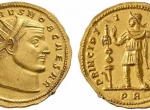 full resolution
full resolution
Fig. 1. Constantin I, Rome (http://www.coinarchives.com/)
-
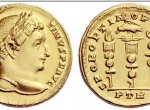 full resolution
full resolution
Fig. 2. Constantine I, Trier (http://www.coinarchives.com/)
-
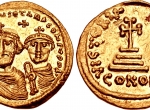 full resolution
full resolution
Fig. 3. Heraklius and Constantin I, Constantinopol (http://www.wildwinds.com/coins/ric/i.html)
-
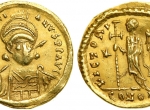 full resolution
full resolution
Fig. 4. Justinian I, Barbaric imitation (http://www.coinarchives.com/)
-
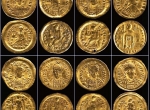 full resolution
full resolution
Fig. 5. The solidi hoard from Karsibór (Photo: G. Solecki, A. Piątek, National Museum in Szczecin)


